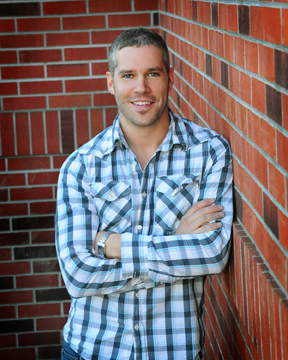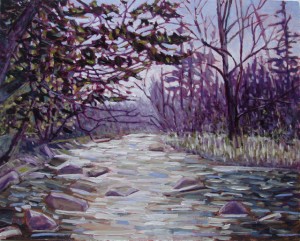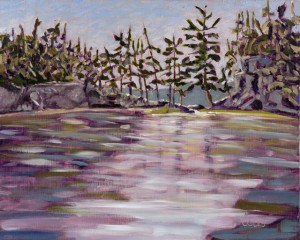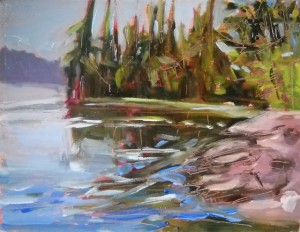“The Rugged Wild” Art Show – Paintings by Matt Coles
December 3, 2011 to February 2, 2012 at The Framing Place & Gallery – Huntsville, ON
Born in North Bay, Ontario, Matt Coles experienced the rugged landscape of the Canadian Shield at a young age. He and his father would go on frequent fishing and camping trips, and Matt developed a love for the outdoors that would later form the cornerstone of his artistic expression.
Matt is a plein air artist now residing in Huntsville, Ontario. He paints the many beauties of the Canadian landscape with a signature style – contrastive colours with sharp, sometimes wild outlines. In selecting a scene to paint, Matt looks for interesting lighting, shapes, and compositional appeal, but he admits there’s something more at work that draws him in.
In addition to painting landscapes, Matt is the Art Director at the Algonquin Art Centre, a world-class gallery and art workshop centre in the middle of Algonquin Provincial Park. This position allows Matt to be at the centre of a burgeoning school of young painters with strong ties both to Algonquin Park and to the Algonquin Art Centre.
Matt’s work breathes new life into a long and rich tradition of Canadian landscape painting, as they express the simple, compelling, and perennial passion of artists in the Canadian wilderness.
Portrait of an Artist – Interview with Matt Coles
by Joel Irwin
What inspired you to start painting?
I’ve always enjoyed art. In my youth I recall working late into the evening on drawings with my parents in the next room thinking I was asleep. It was a way for me to find tranquility. It wasn’t until my employment at The Framing Place & Gallery in 2003 that I took a serious interest in art, specifically paintings. The Framing Place & Gallery became inspirational and monumental. As a professional custom picture framer, I was exposed to a massive array of styles, techniques, and media that in a way drove me to create. Like many Canadian painters, my first real connection with landscape paintings derived from the famous Group of Seven. I spent much of my early career studying the works of these great Canadian masters who journeyed into the wild and conquered the elements in the name of art. Mysteriously I have always felt that the experience and the emotion of the artist translated through each piece.
Who have been the principal influences over your style?
I have a great appreciation for all art but specifically work en plein air. There are a number of artists that inspire me but it’s the artists that I have worked with personally that truly inspire me. I owe a great deal to my friend and mentor Peter Schulz who since day one has believed in my abilities as a painter. As the Art Director for the Algonquin Art Centre, I found influence not only in the stellar skills that surrounded me, but in the natural environment and the historical influence the park has had on artists.
What do you look for in selecting a scene?
There are a few technical components that I abide to such as lighting, overall shape and composition…but what I truly look for is not technical at all, but an emotion that the scene projects.
How would you describe your palette?
Colours are one of the staples of my work. I typically manipulate six colours which I feel comfortable and confident utilizing. My palette is significant as it allows me to be expressive and capture a mood.
What are the benefits in painting en plein aire?
There is a depth to plein air work that differs from that which is produced in studio. An artist out in the elements with the warmth of the sun, the breeze touching their brush, black flies in their paint somehow captures that moment which is translated through what is produced. A plein air artist has to learn to be swift and accurate with each stroke. As the day moves forward, so do the shadows and the light. Thus a plein air artist is consistently challenged by nature and the nature of themselves. This brings a certain energy to the process.
You outline a number of objects with the end of your brush in some paintings. Is this meant to convey the natural patterns that exist in the landscapes themselves? If so, what do you think are the relations between art and nature?
This is a sgraffito technique I experiment with in order to capture movement and add another element to the work. It is meant to capture the pattern of movement in nature. Art in nature are one in the same, almost like math in nature are one in the same in the sense that you can always find patterns and shapes within the landscape or an individual element such as a leaf.
How in your opinion has landscape paintings changed since Tom Thomson and the Group of Seven?
The technologies, tools and accessibility to nature have in some respects changed landscape paintings. Artists have more choices in terms of location, colour. But I have to admit there is a rawness to having limits and the ability and talent it takes to do what you can do with what you got.
Is it true that you’re resurrecting the Algonquin School of Painters?
I do have every intention of resurrecting a modern day version of the Algonquin School of Painters. This already began with my frequent day trips with with Peter Schulz and Mark Reeder. I find complete satisfaction in exploring and painting Algonquin, a world, that in a way can be perceived as “untouched by machine”. When you share this relationship with a fellow painter, you begin to understand the complex relation of art and nature from different perspectives. This can have an incredible impact on how you see nature and in turn how you paint nature.
Why paint?
Paint why.
Click the following link for a recent interview with Hunters Bay Radio
Interview with Hunters Bay Online Radio







